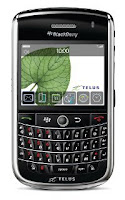
To some the Blackberry Bold was just too big and heavy, well, big and heavy for a Blackberry. That was the first reaction I received when I placed the Bold into the hands of several fans last year and it was only after seeing the performance of its large screen, full feature set, and gorgeous interface that those first impressions were forgotten. Then along came the Blackberry Curve 8900, small and slim as ever, but similarly powerful to the Bold and almost as packed with features. Which to buy? Ultimately you’d want both, or a device that exists between the two, a “missing link” berry. Such is the Blackberry Tour.
The Tour travels such familiar ground that if you have read about or played with any of last year’s Blackberry devices, you can quickly size it up in a glance and for that reason this review will be a little short.
The Tour wears the Bold’s tuxedo well. The black casing and chrome accents, especially around the trackball give it the premium sense of elegance to match the new Blackberry interface. I’m especially fond of the new backing design with its chrome logo and almost Art Deco segmentation. It actually suits the overall style better than the faux leather backing of the Bold.
The Tour’s small size allows it to fit very comfortably in the hand and similar to the Bold the keys on the QWERTY keyboard are indented so your thumbs will catch them as you spread them outwards, but offer no resistance when you move your thumbs to the centre.
One downside of crafting this hybrid is the screen. Now sporting RIM’s higher resolution interface, the 2.5” display falls just short of comfort. The main menu screen is fine for navigating features, but the fine print of web sites, Blackberry Maps, and many applications will induce just enough squinting to force you to change the settings for font sizes and display modes and even then it’s not as comfortable as it is to use on the Bold or Storm.
The Tour ranks among the best of smartphones in its feature set, somehow packing most of what you’d want into such a small body, yet each one works remarkably well. The Tour is a quad-band phone, allowing you to use it globally. It has an excellent 3.2 Megapixel camera, supported by a flash, auto-focus, and even image stabilization. There’s a built-in speakerphone, a proper 3.5 mm headphone jack, and 256 MB of internal memory with a microSD card slot for up to 16 GB more.
The Tour can act as a wireless modem, includes RIM’s Blackberry Maps with built-in GPS and a number of enhancements that come with the new RIM interface including a stylish clock, access to Blackberry World for additional apps, and a media player that can be used with optional software to sync with Apple’s iTunes.
Add that to RIM’s signature e-mail and messaging services and you have a smartphone that delivers one of the best experiences on the market.
What’s missing is Wi-Fi, a rather disappointing omission, and one that continues to perplex Blackberry fans as it shouldn’t be a difficult feature to add. It’s potential to shorten the battery life isn’t enough to justify its absence and including it would have only supported the idea of creating a Blackberry that offered the best of past models. Why try to create a Blackberry that delivers the best of all worlds only to fall short on one feature?
Wi-Fi is important, not because it can allow users to switch off their 3G connections and cancel their data plans, but because it can be used to help manage their monthly data usage and keep it under the limits. If you tend to leave your Blackberry on at night while you sleep, best to have it connected through Wi-Fi for free. Why pay for something that happens while you sleep and have no control?
While the Blackberry Tour delivers one of the best Blackberry experiences for CDMA-based networks Telus and Bell, against RIM’s past work it still falls short of the BlackBerry Bold. The gain you get with a smaller form factor does not make up for the loss that comes with a smaller screen and a lack of Wi-Fi support. The Bold is still the best Blackberry on the market.




